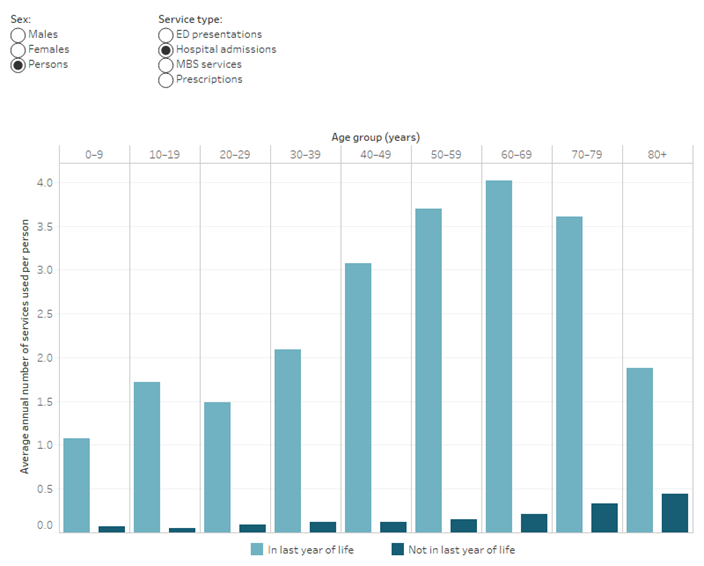Resources for Health Service Organisations - End-of-Life Care and Accreditation against the NSQHS Standards
2104 0
A blog written by Vanessa Heading, Project Manager, End-of-Life Essentials, Flinders University
Many Australians die an expected death in an Australian hospital every day, and this has been a trend for many years [1]. People who are in the last year of life, on average, are far more likely to be admitted to hospital ( Figure 1 below) [2]. These figures show the average annual number of hospital admissions, and many individual Australians will have a higher number of hospitalisations in the last year of life. Frailty, sickness, and exacerbation of illness make repeat admissions in the last year of life common. It is important to remember though, that these figures do not show or reflect the quality of care provided which is often not optimal. It is therefore crucial that hospitals support clinicians and implement systems to provide excellent End-of-Life Care (EOLC) to all people approaching the end of life.
Figure 1: Average annual number of health services used (a) per person by sex, age, service type (hospital selected) and whether in last year of life.

Notes:
- Analysis for the In last year of life group includes services used by this group in the last 12 months before their death. This includes services used between 1 July 2010 and 31 December 2016, presented as average number of services used, per person.
- Analysis for the Not in last year of life group includes services used by this group between 1 July 2010 and 31 December 2016, presented as average number of services used per person over a 12-month period.
- See Technical notes for more information on the linked dataset, study groups, services and costs used in this study.
Source: AIHW National Integrated Health Services Information Analysis Asset version 0.5. https://www.aihw.gov.au/
The National Safety and Quality Health Service (NSQHS) Standards determine the level of care that consumers can expect from health service organisations (NSQHS). Accreditation to assess the quality and safety of care and service provided to Australians at the end of life is covered in the Comprehensive Care Standard.
End-of-Life Essentials (EOLE) has expanded our resources to assist quality assurance managers, clinical governance officers and clinicians learn more about delivering quality and safety of EOLC. In doing so we have a suite of materials, including:
In collaboration with the Australian Commission on Safety and Quality in Health Care (ACSQHC), EOLE held a series of national workshops in 2021. We aimed to understand the attendees’ experiences of hospital accreditation, and assessment against the Comprehensive Care Standard – what’s working, and what’s a challenge? Industry representatives from across Australia attended the workshops and were very generous with sharing their time and expertise. The findings of the workshops supported the development of the new, recently released EOLE education modules and resources developed for Managers and Quality Assurance Staff. We also learnt that:
- Terminology regarding ‘End-of-Life’ is not clear within the clinical workforce. End-of-Life is not referring to just the last days of life (terminal phase). It is important to understand that it does encompass people living with serious illness who can ‘walk out of hospital’ and are able to participate in their daily living activities.
- EOLC requires hospital executive level endorsement and support, as well as Heads of Departments endorsement to support quality EOLC as core business.
- Data driven change and implementation is important as the use of base line audit and allows for identification of how organisation is performing.
Hospitals are so important for our communities. They are also complex places where policies, processes and systems need to be responsive, and focussed to provide excellent EOLC and services across communities. We aim to continue to work with the hospital sector to produce and provide quality education and resources and to learn more from hospital communities about their challenges and innovations in implementing excellent EOLC.
References
- Swerissen, H and Duckett, S., 2014, Dying Well. Grattan Institute ISBN: 978-1-925015-61-4
- Australian Institute of Health and Welfare. (2022). The last year of life: patterns in health service use and expenditure. Retrieved from https://www.aihw.gov.au/reports/life-expectancy-deaths/the-last-year-of-life-health-service-use-patterns

Vanessa Heading
Project Manager
End-of-Life Essentials